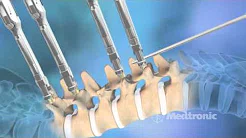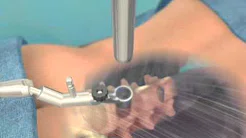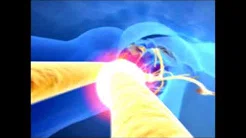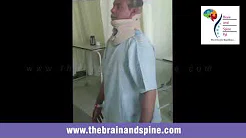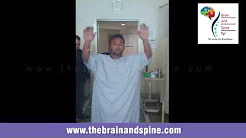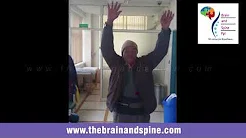Spinal Cord Trauma
The spine is one of the most crucial and delicate parts of the human body that may get injured due to various activities like accidents, sports injuries, falls, violence, etc. Although the spine is well protected by discs, ligaments, and muscles, but is still vulnerable to traumatic injury as the rest of the skeletal system.
The spinal cord contains the nerves and passes from neck to back to transfer messages between the brain and body. So any injury to the spine can cause loss of movement (paralysis) below the site of the injury. Any kind of damage to the spinal cord either directly or indirectly due to damage of vertebrae, ligaments, or disks of the spinal column is termed spinal cord trauma. Such damage often causes permanent changes in strength, sensation and other body functions.
Risk factors of Spinal cord trauma
Although trauma can happen to anyone the following risk factors may predispose a person to spinal cord trauma:
· Males are affected more than females
· Age between 16 and 30 years or above 65 years
· Engaging in risky activities like driving or playing without safety etc.
· A bone or joint disorder such as arthritis or osteoporosis
· Weak individual
Causes of Spinal cord trauma
The spinal cord may get injured due to any of the following reasons:
· A sudden, traumatic blow to the spine resulting in fracture, dislocation, crush, or compression of one or more vertebrae
· Motor vehicle accidents
· Sports and recreation injuries
· Assault or other acts of violence
· Fall from a great height
· Landing on the head during a sports injury
· Gunshot or knife wounds that can penetrate and cut the spinal cord
· Diving accident
· Electric shock
· Extreme twisting of the middle of the body
· Disorders like arthritis, cancer, inflammation, infections or disk degeneration of the spine may also injure the spinal cord (non-traumatic injury)
Classification of Spinal Trauma
Spinal trauma can be classified under the following:
· Thoracic (chest level) injuries
· Lumbo-sacral (lower back) injuries
· Cervical (neck) injuries Diagnosis of Spinal cord injury It is an emergency condition that requires immediate medical care and evaluation of the damage.
This requires a thorough physical examination by the physician along with the following diagnostic tests:
· X-ray
· CT scan
· MRI scan
· Myelogram
· Somatosensory evoked potential testing or magnetic stimulation, etc.
Symptoms of Spinal cord trauma
The symptoms of spinal cord trauma may vary depending upon the location, type, and severity (complete or partial) of the injury and include: · Loss of movement · Loss of sensation, including the ability to feel heat, cold, and touch
· Loss of bowel or bladder control
· Pain, stiffness or stinging sensation due to damage of nerve fibers
· Numbness in hands, fingers, feet or toes
· Weakness & incoordination
· Paralysis of part or whole body
· Lack of alertness
· Exaggerated reflex activities or spasms
· Difficulty in walking, standing, breathing, coughing, etc.
Treatments
Spinal Trauma Surgery
Spinal trauma or spinal cord trauma is a medical
emergency that requires immediate medical care. If left untreated, it may cause
long-term effects. Mild to moderate injuries can be cured with medications and
other treatments. Surgery is generally performed in the following cases:
- To remove tissue or fluid that presses on the spinal cord
- To fuse broken spinal bones or place spinal braces
- To remove disk fragments, bone fragments, or foreign objects
- To realign the spinal bones
- To release pressure from the injured area
Surgery for spinal trauma is most commonly done by
endoscopy or minimally invasive techniques that require only local anesthesia.
These are safer and faster techniques that allow early healing with less
damage.
There is a number of surgical options for spinal cord injury depending on the
location, severity, and type of the injury. But before narrowing down on the
surgery, various diagnostic tests are performed to thoroughly understand the
abnormality and have a clear image of injury. The diagnostic tests include
X-ray, CT scan, and MRI, etc. of the spine. If the injury is not severe, the
surgeon may suggest non-surgical treatment but in severe cases, the surgeon
opts for any of the following surgeries to treat spinal cord injury:
- Micro-Endo
discectomy: A surgery generally performed with a
minimally invasive technique to remove a small part of the ruptured disc.
- In the cervical region, the complete disc is
removed and is almost always followed by fusion.
- In the thoracic and lumbar region, a part of
the disc which is causing compression is removed, sometimes a near-total
removal of a disc with fusion is required, depending upon the stability
of spine.
- Spinal
fusion: A procedure to fuse or join two or more
vertebrae in the spine. Spinal fusion surgeries are of different types
including:
- Anterior lumbar interbody fusion
- Posterior lumbar interbody fusion
- Transforaminal lumbar interbody fusion
- Minimally
invasive spinal fusion: A minimally invasive technique for lower
back pain due to degenerative disc disease or contained disc herniation
caused by spinal trauma. Here a the para-spinal trans muscular approach is
used to decrease the morbidity and early restoration of the daily life
- Surgical
decompression: It is a generalized term given to
procedures that relieve symptoms caused by pressure, or compression, on
the spinal cord and/or nerve roots. Different kinds of surgical
decompression methods are:
- Foraminotomy is
the removal of bone and other tissue of the spine to expand the openings
for the nerve roots to exit the spinal cord
- Laminotomy is
the removal of just a section of the lamina of the spinal canal
- Laminectomy is
the removal of the entire lamina of the spinal canal
- Corpectomy is
the removal of the body of a vertebra, as well as the disks
- Laminoplasty is
the reconstruction of the laminar arch to increase the space available
for the spinal cord
- Kyphoplasty/Vertebroplasty: Minimally
invasive procedure to treat pain and other symptoms caused by the spinal
fracture.
- Anterior
Cervical Discectomy and Fusion: A treatment option for neck
problems due to fractures, spinal instability, and herniated disc.
- Spinal Cord Stimulation: It is the procedure of surgical implantation of a spinal cord stimulator under the skin to send electrical impulses to control or relieve chronic spinal pain.


 Request an Appointment
Request an Appointment Request Online Consultation
Request Online Consultation Enquiry form
Enquiry form









